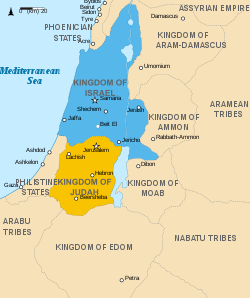The Negev region in the Hebrew Bible
The Bible contains several traditions regarding the Beersheba-Arad Valley and the Negev Highlands, which can be broadly categorized into two groups. From the first group, older biblical scholarship inferred that the Negev was inhabited by the ancient Israelites during biblical times. According to the second group, a different people lived here; this group aligns more with the findings of more recent archaeology (see below).
(1) According to the Book of Genesis, already Abraham lived for a while in the central and biblical Negev after being banished from Egypt. [12] Notably, he spent a brief period living in Kadesh [Barnea] [13] and later resided as a guest in Beersheba, which at that time was purportedly part of the kingdom of the Philistine king of Gerar. [14] (2) Accordingly, Numbers 34:1–7 and Joshua 15:1–3 [15] are generally understood to mean that the biblical and central Negev actually belonged to God's Promised Land at least down to Kadesh Barnea at the southwestern fringes of the central Negev (but see below). This area is assigned to the Tribe of Judah [16] along with other more northerly areas. Simultaneously, the biblical and central Negev is assigned elsewhere to the Tribe of Simeon within the territory of the tribe of Judah. [17] (3) Hence, when the Israelites came from Egypt to Israel, according to Numbers 20:1–21:3, [18] only Aaron is not allowed to enter this land because he has sinned — the rest of the Israelites, however, can conquer the area.

(4) Conversely, according to Deuteronomy 1–2, [19] the area is revoked from the Israelites by God because everyone has sinned and God has also destined the land for the Edomites. [20] (5) The background for this is found in Genesis 32:3; 33:12–16, [21] where it is not Jacob, the ancestor of the Israelites, who lives there, but his brother Esau, the ancestor of the Edomites. These two grandsons of Abraham divide the promised land between them in Genesis 36:6–8 [22] so that this "Edomite land" will continue to be inhabited by Edomites. (6) According to the Books of Kings, the Edomites also live here. They are sometimes ruled by Israelite kings, as the Negev was purportedly part of the kingdom of the legendary king Solomon (in its entirety, all the way to the Red Sea), [23] and from the 9th century, with varied extension to the south, part of the Kingdom of Judah. [24] But the Edomites fight against them multiple times and regain their freedom. [25] [26] (7) The most common expression used in the Bible to refer to Israel as a whole is "from Dan to Beersheba." Once again, this excludes at least the central and southern Negev regions from "Israel". (8) Accordingly, it is not at all certain whether the border descriptions in Numbers 34 and Joshua 15 really include the Negev as part of the promised land, as Numbers 34 also presupposes an area of Edom west of the Jordan (which, according to Numbers 20:14-16, [27] begins at Kadesh as one of its southernmost locations). For that reason, it has recently occasionally been suggested that "Your southern border shall be from the Wilderness of Zin along the border of Edom" (Numbers 34:3) is to be understood as excluding the territory of the Edomites, and therefore at least the central and southern Negev, from the Promised Land. [28] [29] However, as of yet, this is still a minority opinion.




